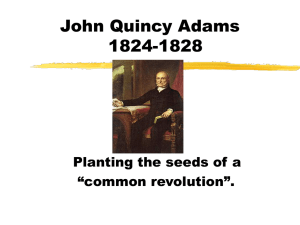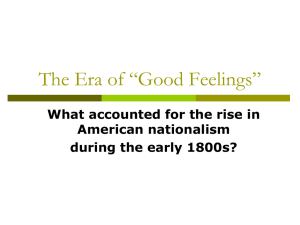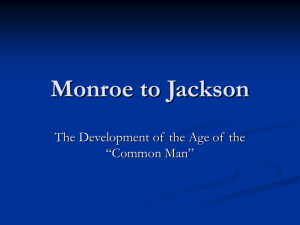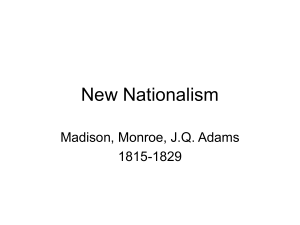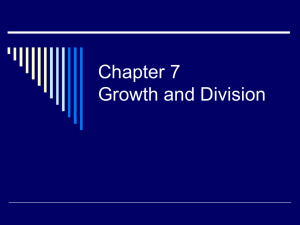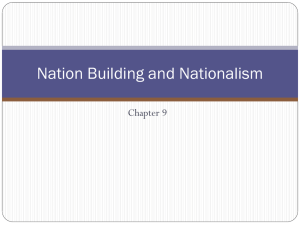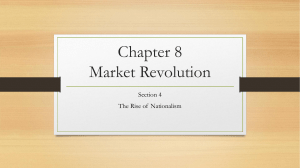Monroe to Jackson PPT
advertisement
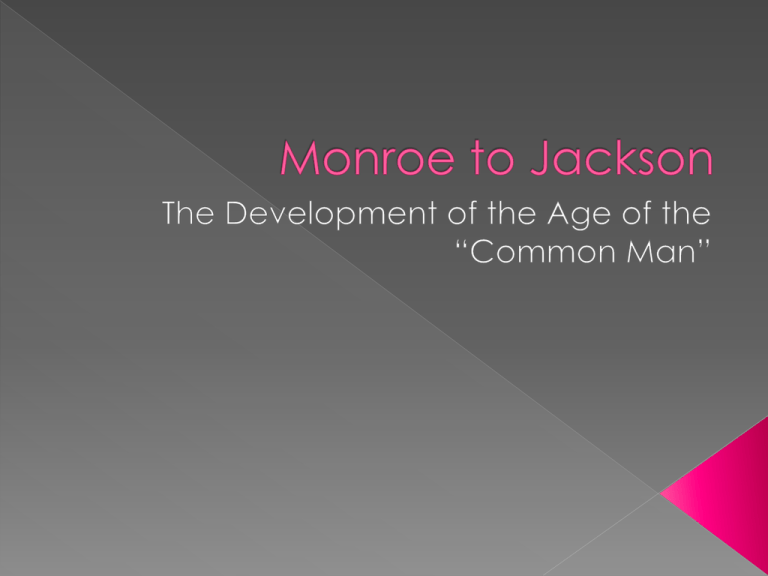
Western Expansion- people move West, Indian land is confiscated › Conflict and Compromise: Slavery expands with the movement of people West causes political compromises (Missouri Compromise) Industrialization- factories, cities, immigration Transportation- networks increase, roads (Turnpikes), canals, steamboats (Fulton), railroads increase in this period After the War of 1812 and the downfall of the federalist party (Hartford Convention) there is a huge feeling of Nationalism- › The idea of loyalty or devotion to a nation, or › Pride in one’s country, usually excessive Madison unveils a program to develop the country through the leadership of the Federal Government: Military, banking, protective tariffs, internal improvements (roads, canals), and a national university Military Banking- Chartering the Second Bank of the United States -first bank, time ran out and paper money issued caused inflation Bank is created 1816› became economically strong › McCullah vs. Maryland- Marshall-ruled that the Bank was legal and states could not tax it. Protective Tariff- During Embargo, manufacturing in Northeast develops, Brits produce more goods, cheaper, and faster Textile industrialists, (Lowell) support tariff Even Calhoun of South Carolina, supported the tariff, because of nationalistic or patriotic reasons. Monroe won by some of the biggest electoral college totals in U.S. political history; Federalist Party did not even exist by 1820 Note the addition of five new states between 1816 and 1820; reflects the growth of the U.S. “Era of Good Feelings” Is a common term related to the period of time where there was a drastic reduction of political infighting, (Federalists are all but extinct) › International problems are drastically reduced › High level of Nationalism and optimism People in the US are on the move economically, and geographically (Westward Expansion) › Nationalism The idea of loyalty or devotion to a nation, or Pride in one’s country, usually excessive Americans look inward to developWest/transportation/economic development/ Problem-sectionalism continues Follows Madison’s Platform Now Supported large navy Supported Charter of Second Bank of US Protective Tariff Internal Improvements Similar to Madison’s Platform ideas (Clay is associated with supporting plan) 1. Protective Tariff- to pay for improvements 2. National Bank- organize finances of the government 3. Internal Improvements- roads, canals (this became an issue for some states’ rights congressmen) In the years before 1819 European countries were disrupted by Napoleon’s War American goods- cotton and agriculture were in high demand, causing prices to rise › Cotton 1815-.20 cents lb › 1816-.30 cents lb › 1818-.33 cents lb Causes land prices to rise, many land speculators and farmers borrow $ to buy land, When the price of goods goes down due to reduced demand, farmers, speculators and banks go broke- this causes a depression for 6 years. Three Congressmen will help temper Sectional Interests and help make compromises for a generation. Congressman Daniel Webster of Massachusetts 1812-1852 By the 1820s, three distinct regions were emerging in America The North was characterized by: › growing industry (especially textile mills in New England) › urbanization (ex: New York City) › increasing immigration (especially from Germany and Ireland) › reform movements to better society, including abolition movements › support for strong national government, including the “American system” › Daniel Webster of Massachusetts emerged as a leading spokesman of this region Congressman John C. Calhoun of South Carolina 1811-1850 The South was based on: › support for states’ rights and a weak national government › commitment to the continuation and expansion of slavery › the growth of “King Cotton” as the major money maker › a hierarchical society, in which wealthy planters dominated society and had most of the political power › opposition to tariffs and federal support for infrastructure; these policies only benefitted the North and West › Supported the idea of “Nullification” › John C. Calhoun of South Carolina emerged as the major spokesman Speaker of the House Henry Clay of Kentucky 1811-1849 (died in office) This region included the entire Trans-Appalachian region but eventually became associated with the Midwestern and Far Western states and territories The West’s interests were based on: › westward settlement by pioneers › agricultural boom due to the growing demand for grain to › › › › feed Americans a positive economic relationship with the Northeastern states, which provided manufactured goods in exchange for food support for tariffs and infrastructure projects to tie the country together neutrality on the slavery issue Henry Clay of Kentucky emerged as the spokesman for this region John Quincy Adams, the son of President John Adams, of Massachusetts. Secretary of State for Monroe Follows a Nationalist policy 1. Expand American Territory 2. Reduce European Influence in the Western Hemisphere Adams negotiated British-American Convention (Treaty of 1818 ) set a final settlement to the border of Canada- 49° parallel – legitimacy of Louisiana Purchase Adams-Onis Treaty (Spain) 1819 › Florida, after War of 1812, › Monroe ordered Andrew Jackson protect the Georgia border › Seminole Indians in Florida› Adams was able to get the Spanish to sell Florida to US in exchange for assumption of American Claims from the Napoleonic Wars Latin America was in the process of gaining independence from Spain European powers threatened to reassert control in the Western Hemisphere Adams wrote: › No (New) European Colonization in Western Hemisphere › Isolation (US will not intervene in European Wars) › Non-Intervention (Europeans were to keep their hands off the Americas) Significance/Effects- Americans will cite the Monroe Doctrine in future issues of Foreign Policy British Support Adams: “The American continents are henceforth not to be considered as subjects for future colonization by any European Power.” “Our policy in regard to Europe … is not to interfere in the internal concerns of its power.” 1819 Missouri wants to enter the Union as a slave state The issue of Slavery emerges again North and South don’t want to lose power (i.e., votes in Congress (states had entered in pairs slave/free especially the Senate)) 1819- 11 free and 11 slaves states Henry Clay works out a deal, › Missouri enters the union as a slave state › Maine enters as a free state › Territory of the Louisiana purchase above 36°30’ could not have slavery The Compromise resulted in stability of the Union…for now It also resulted in increased sectional/political division Jackson, Adams, Clay, Crawford No clear majority in Electoral College According to the 12th amendment, House of Reps choose between the top three candidates with the highest number of electoral votes Clay throws support to Adams Jackson won the popular vote, popular in the WEST as a military hero- stood for slavery, nationalism, protective tariff John Quincy Adams wins Jackson will claim a “Corrupt Bargain” was struck between Adams and Clay- appointed Secretary of State) Resulted in the SPLITING OF THE REPUBLICAN PARTY Democratic Party, Supporters of Jackson will unite (Closer to Jeffersonian Republicans) Whig Party Supporters of Henry Clay (closer to Federalists) › 1. Protective Tariff- to pay for improvements › 2. National Bankorganize finances of the government › 3. Internal Improvements- roads, canals (this became an issue for some states’ rights congressmen)

